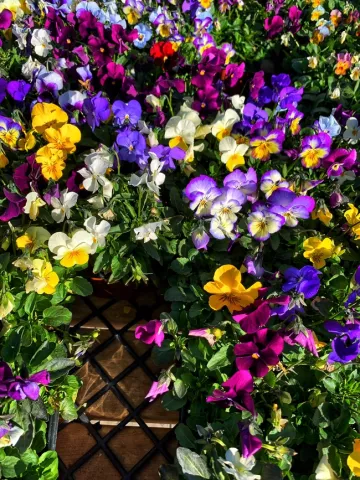Violas

Violas
By Deborah Light-Pacheco UCCE Master Gardener
Common name of plant: viola, violet, pansy
Scientific name: Violaceae
Planting area: Sunset zones vary by species
Size: low growing, 5-7 inches
Bloom Season: some are annuals, some perennials
Exposure: part to full sun; varies by species
Pruning needs: to prolong bloom, pick some flowers/leaves and remove all flowers as they fade and prior to their setting seed
Water needs: regular
Snapshot: Bright and perky violas, also known as violets and pansies (larger flowering variety), are mostly considered perennials. However, some varieties are grown as annuals. They bring light to the garden in winter and spring with blooms in mild climates. In cold climates, they bloom spring through summer. Violas come in many colors and color variations and are wonderful to use as borders and in containers. They are especially pretty when planted around potted bulbs. They'll provide color whilst the bulb lies dormant and will continuing to encircle the bulb once it blooms. These plants can take sun and partial shade. Full shade is not recommended.
Most violas have two types of flowers – those that are visible and those that are not visible. The visible flowers produce seed that requires pollination. The less obvious blooms develop an abundance of seed which need no pollination. Interestingly, these seeds are clones of the parent plant.
Violas require little maintenance when planted with a quality organic soil that is kept moist and well-drained. They are relatively disease free and are not prone to insect issues. To prolong the bloom period, pinch a few flowers along with the stem and foliage and always remove fading flowers prior to setting seed. Violas can be easily propagated as well by root division and stem cuttings.
Violas will enhance any garden with a wide range of colors that are available at your local nursery year-round.
Advice to Grow By Workshops
Our next workshop will be April 15th, 2023, at 10:00 to 12:00 p.m. in our Seven Sisters Demonstration Garden at 2154 Sierra Way, San Luis Obispo. The topic will be “Orchids and Dahlia's part 2”. All about planting, care of Dahlias, how to grow orchids and how to keep that supermarket orchid alive”. Visit our website to register. The workshop is free and open to the public. Docents will be available after the workshop until 1:00 pm. If inclement weather, the workshop will be cancelled.
Other ways to see or reach us:
You can view workshops on Instagram live at slo mg or visit our You Tube channel at “San Luis Obispo County UC Master Gardeners.”
Visit our website at ucanr.edu/sites/mgslo/ or email questions to anrmgslo@ucanr.edu.
UCCE Master Gardener Helpline offices:
San Luis Obispo: 805-781-5939 (Monday and Thursday 1:00 to 5:00)
Arroyo Grande: 805-473-7190 (10:00 to 12:00)
Templeton: 805-434-4105 (Wednesday 9:00 to 12:00)
